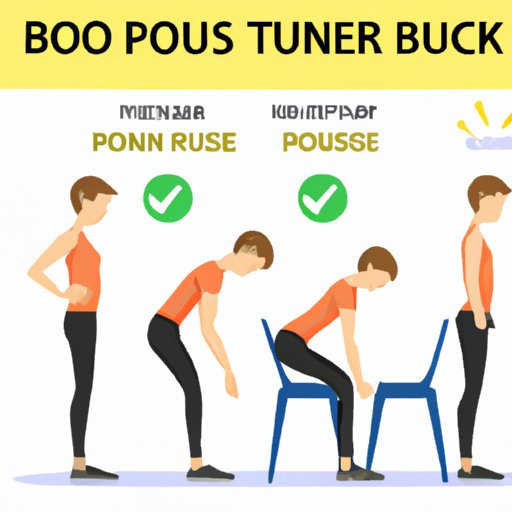
Introduction
Do you experience lower back pain frequently? You’re not alone. According to the American Chiropractic Association, 80% of adults experience lower back pain at some point in their lives. Back pain can be caused by an injury, poor posture, weight gain, or the natural aging process. It can also affect your daily activities, work, and overall quality of life.
One way many people alleviate their lower back pain is by popping their lower back. While this can provide temporary relief, it can also be dangerous if not done properly. In this article, we will explore how to safely pop your lower back and other ways to alleviate lower back pain.
The Benefits of Popping Your Lower Back and How to Do it Safely
Before discussing safe techniques for popping your lower back, let’s explore the benefits of doing so. Popping your lower back can help reduce tension, stiffness, and pain in the lower back area. It can also improve your mobility and flexibility.
However, there are precautions that you should take before attempting to pop your lower back. First, you should consult with a physician and make sure that it’s safe for you to do. There are some conditions that may be contraindicated. Second, you should learn proper techniques to avoid injuring yourself.
Safe techniques for popping your lower back include:
1. Seated spinal twist – Sit on a chair with your feet flat on the floor. Twist your upper body to the left while holding onto the back of the chair. Hold the stretch for 10-20 seconds, then twist to the right and repeat.
2. Knee-to-chest stretch – Lie on your back with your legs extended. Bend your right knee and place your hands behind it. Gently pull your knee towards your chest and hold for 10-20 seconds. Repeat with your other leg.
3. Pelvic tilts – Lie on your back with your knees bent and feet flat on the floor. Tighten your abdominal muscles and tilt your pelvis towards your head. Hold for 5-10 seconds, then release.
Exercises and Stretches You Can Do to Alleviate Lower Back Pain
While popping your lower back can provide temporary relief, it’s important to address the underlying cause of your lower back pain. By doing exercises and stretches that target the lower back area, you can alleviate pain and improve your posture.
Types of exercises that can help with lower back pain include:
1. Bird-dog exercise – Start on your hands and knees, with your wrists under your shoulders and knees under your hips. Extend your left arm and right leg out straight. Hold for 2-3 seconds, then switch sides and repeat.
2. Quadruped rock back exercise – Start on your hands and knees, with your hands under your shoulders and knees under your hips. Rock backwards towards your heels, stretching your arms out in front of you. Hold for 5-10 seconds, then return to the starting position.
Stretches to alleviate lower back pain include:
1. Child’s Pose – Start on your hands and knees, with your wrists under your shoulders and knees under your hips. Lower your hips back towards your heels, stretching your arms out in front of you. Hold for 10-20 seconds.
2. Cat-cow stretch – Start on your hands and knees, with your wrists under your shoulders and knees under your hips. Arch your back and look up towards the ceiling (Cow Pose), then round your back and chin towards your chest (Cat Pose). Repeat for 10-20 repetitions.
It’s recommended to do exercises and stretches for lower back pain at least three times per week. It’s important to listen to your body and avoid overexertion, which can cause more harm than good.

The Importance of Good Posture and How It Can Prevent the Need to Pop Your Lower Back
Poor posture can lead to lower back pain and other health problems. When you slouch or hunch over, it can put undue stress on your spine, leading to compression, tension, or misalignment. By maintaining good posture, you can protect your spine and prevent the need to pop your lower back.
Tips for maintaining good posture include:
1. Sit up straight with your back against the chair, and feet flat on the floor.
2. Keep your shoulders relaxed and your chin level.
3. Avoid sitting or standing for long periods of time, and take breaks to stretch or walk around.
Good posture can also have other health benefits, such as reducing stress, improving breathing, and boosting confidence.
How to Pop Your Lower Back on Your Own Without Hurting Yourself
If you choose to pop your lower back on your own, it’s important to do so safely and carefully. Here are step-by-step instructions for popping your lower back:
1. Lie on your back with your knees bent, and feet flat on the floor.
2. Place your hands on either side of your lower back.
3. Slowly lift your hips off the ground, using your arms for support.
4. Hold this position for 10-20 seconds, then lower your hips back down.
If you feel any pain or discomfort during this process, stop immediately. Popping your lower back too forcefully can also cause injury or exacerbate pain. If you’re unsure about how to pop your lower back safely, consult with a chiropractor or other medical professional.
The Risks of Popping Your Lower Back and When It May Be Necessary to See a Chiropractor
While popping your lower back can provide relief, it can also have potential risks and complications. If you have a pre-existing medical condition, such as herniated disc or osteoporosis, popping your lower back can worsen your condition. It can also cause muscle strain, sprain, or joint damage.
If you experience chronic or severe lower back pain, or if popping your lower back doesn’t provide relief, it may be necessary to seek professional help. A chiropractor can assess your condition and provide appropriate treatment, such as spinal manipulation or physical therapy.
How Massage Therapy Can Help Relieve Lower Back Pain and Reduce the Need for Popping It
Massage therapy can also provide relief for lower back pain. Different types of massage therapy, such as Swedish massage, deep tissue massage, or trigger point therapy, can target your muscles, joints, and connective tissues.
Benefits of massage therapy for lower back pain include:
1. Improved blood circulation and lymphatic drainage
2. Reduced muscle tension and inflammation
3. Increased mobility and flexibility
It’s recommended to get a massage at least once a month for maximum benefits. It’s also important to choose a licensed massage therapist who specializes in treating lower back pain.
Lifestyle Changes, Such as Weight Management and Quitting Smoking, That Can Reduce Lower Back Pain and Improve Overall Health
Finally, lifestyle changes can also play a role in reducing lower back pain and improving overall health. If you’re overweight or obese, losing weight can reduce the pressure on your lower back and other joints. If you smoke, quitting can improve blood circulation and reduce inflammation.
Other lifestyle changes that can help with lower back pain include:
1. Getting enough sleep and rest
2. Drinking enough water and limiting caffeine and alcohol
3. Using ergonomic furniture and tools
4. Practicing stress management techniques, such as meditation or yoga
Conclusion
In conclusion, popping your lower back can provide relief, but it’s important to do so safely and carefully. By doing exercises and stretches, maintaining good posture, getting professional help if necessary, and making lifestyle changes, you can reduce lower back pain and improve your overall health. Remember to listen to your body and seek medical advice as needed.





